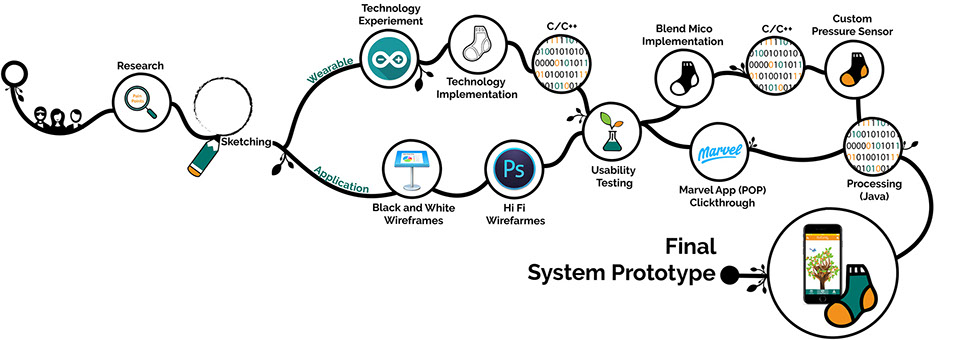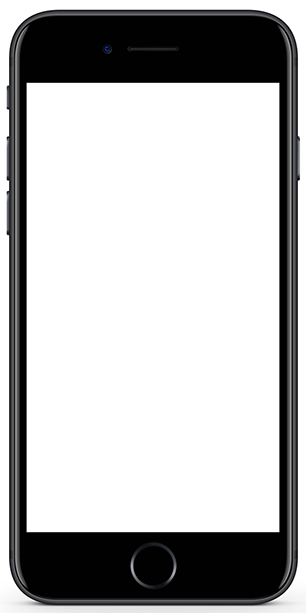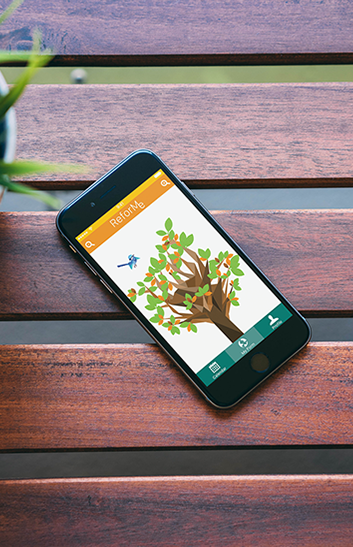
ReforMe
Setting
The University of Sydney
Semester 2 2016
DECO3200 - Interactive Product Design Studio
Created by Christopher Simpson, Isabella Bain and Zachary Bacon
Project Background
The objectives for the third year assignment was to in 12 weeks design a solution that would help support the health and well-being of a user. Through the use of interactive technologies carried on the body and/or embedded in the user’s environment. Our goal was to find an area of health that we were interested in and then explore avenues that we could implement a solution to help improve user’s mindfulness, health and wellbeing.
Solution Overview
ReforMe is a wearable technology solution and mobile application that assists in the rehabilitation of musculoskeletal disorders (MSD) currently focusing on knee rehabilitation. Moving into the area of smart clothing, patients wearing ReforMe are able to track, analyse and report their rehabilitation while having the support our application. Utilising an Electromyography (EMG), Flexible variable resistor and a customer built pressure sensor we are able to track rehabilitation exercise targets, maintain exercise schedules, recommended activities and build a supportive community around the user. ReforMe’s ‘Social Forest’ reflects the communities combined rehabilitation progress, empowering and rewarding their hard tiresome journey.


Product Video




Grounding Research & Project Justification
Disorders (MSD) are injuries and disorders that affect the human body’s movement or musculoskeletal system (muscles, tendons, ligaments, nerves, discs, blood vessels). Currently 28% of Australians are effected by some spectrum of MSD. Presently the blanket definition allows for the consideration of all risk factors that may accompany injuries, instead of only one. This definition also opens up the conversation about the shared responsibility between the employer and employee, with MSD being the single largest category of workplace injuries. In 2011 MSD was responsible for almost 30% of all worker’s compensation costs in the U.S., with direct costs to companies up to 50 billion dollars.
Due to the increasing demographic with the decision was made to focus on lower limbed MSD, however maintaining the long term Potential that this solution would be transferable to a more inclusive of all MSD/ Rehabilitation patients in the future. As stated by the Australia Institute of Health and Welfare between 2004 and 2014 within Australia there was a 32% increase of knee replacement surgery. 2 in 10 MSD patients had also reported experiencing a poorer quality of mental health and general wellbeing during surgery and rehabilitation time.

Common causes of MSD
Poor Work Practices. This is when individuals use poor working procedures, body mechanics and lighting techniques. These factors can create unnecessary stress on their bodies.
Poor Overall Health Habits. Includes individuals who smoke, drink excessively, are obese or exhibit numerous other poor health habits increase their overall risk of MSD.
Poor Rest and Recovery. MSD’s develop when fatigue passes the ability of the individuals recovery system resulting in musculoskeletal imbalance.

After finding these specific statistics pointing at our chosen target audience we were able to define our problem statement as being; To create a wearable technology solution for lower body musculoskeletal disorders (MSD) to better educate, assist and enhance the patient experience during their physical rehabilitation therapy.
Using this as the foundation we now defined our primary user as early age professionals recovering from lower limb related MSD injury returning to their normal daily activities. The pain points we identified included; a possible rehabilitation time of 7 weeks to 7 months on average, possible direct costs of $15,000 to patient and indirect cost of $75,000 per patient.
For us to best support our users it was paramount that we created a product that would not identify or red-flag patients as being effect by or suffering from MSD and the negative community stigma that can come from this.
The best approach was to embed extrinsic motivation into our system, defined as techniques such as badges, competition, money and rewards as it is most effective “for simple, rote tasks” - Kumar and Herger, like the rehabilitation process. Our system would discreetly notify, motivate and track the user’s movements so that they could make a stronger, faster and more successful recovery while working in tandem with the physiotherapist.
“Following knee injury or surgery, knee rehabilitation therapy is an essential step to recover normal joint function for daily activities. Physical rehabilitation can take several weeks or even months until full range of motion and joint flexibility are regained. Knee rehabilitation will lead to satisfactory results only at the condition that exercises are performed regularly. ” - Agathe Koller-Hodac
“It is pivotal that technological development takes into account patients’ views in that it should be: small, light, discrete, not ‘appear medical’ or challenge the identity of the user.” – Dr Enrica Papi
Mood Boards
During the research phase a series of mood boards were created to captured initial style and concept of both the wearable system and the mobile user interface design.
Additional Research
Mindfulness
Mindfulness can help improve physical health across a range of methods. These techniques can be applied to physical therapy as patients are required to spend large amounts of time doing exercises to reform muscle growth and general strength in the body. By using mindfulness techniques in combination with these exercises patients are able to improve mental space and general health and wellbeing.
Motivation & Gamification
There are two main types of motivation: Intrinsic motivation which involves motivation via autonomy, mastery, learning and finding meaning or Extrinsic Motivation techniques such as badges, competition, money, rewards. Kumar and Herger explain that “extrinsic motivational techniques are effective for simple, rote tasks” and that “for complex problem-solving tasks, people are intrinsically motivated by a sense of autonomy, mastery, and meaning.’’ (2013). Based on this definition ReforMe will be designed to encompass extrinsic due to the rote nature of rehabilitation exercises. Another key concept when utilizing gamification in design is flow. Flow is the balance between frustration and boredom. Kumar and Herger state, “When a task is too difficult, it causes people to be anxious. When a task is too easy, it causes boredom.” (2013) A state of heightened focus and immersion is achieved when the balance between the two is just right. This is known as the flow state.
4 Types of Fun
Hard fun which provides the opportunity for challenge, mastery and feelings of accomplishment
Easy fun inspired by exploration and role play
Serious fun refers to purposeful play and changes how players think, feel, behave and make a difference in the real world
People fun provides an excuse to hang out with friends
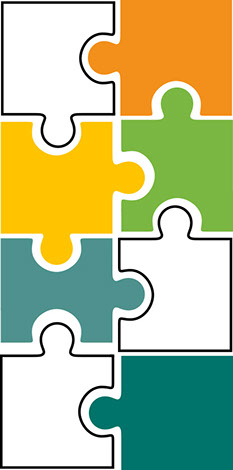
User Research
Key Quotes from Physiotherapist (Stakeholders)
Factors stopping recovery: Job requirements, sitting posture, core strength, motivation, education.
Current Technology: The ViMove (existing EMG based solution) is fiddly and hard to use in clinical practice and expensive to give to people to take home. Dependent on pain patterns, muscle imbalances, posture
Activities during recovery: increase reps/sets, added free weights, progression of exercise difficulty – Clamshell, bridge, singe leg bridge, wall squat, squat, plank, double leg raises, sit up
Attitudes during recovery: Changing depending on how well you educate their situation – initially start with a time line so they know what is going on/coming up – kind of hard to begin.
Key Quotes from Patients (Users)
“Most stressful part was the first 8 weeks post the operation - not being able to do anything active as my arm was in a sling which limited my daily activities a whole lot.”
“Annoying part is having to do exercises that can hurt a bit, I forget to do my at home rehab exercises not once a day but at least 3 times which is difficult when you have a full day of things to do as it's easy to forget.”
“My muscles had deteriorated quite substantially so I had to build them back using the therapy band and going to the gym. It was really tedious and boring. A lot of simple exercises.”
“Towards the end of my recovery I just wanted to get back into running and playing sport. I slacked off on the excursuses using the therapy band and things like calf raises beaches I just wanted to run”
User Research Takeaways
Key Demographic
18 to 58 year old MSD patients who are undergoing an average of 3-8 months of rehabilitation.
Current User Pain Points
- Rehabilitation exercises are really tedious and boring.
- Many of the exercises are relatively simple, but repetitive.
- Users often forgot to complete rehabilitation exercises.
- Users attitudes changed depending on how educated they were on the recovery process.
- Initial rehabilitation time line vary on a patient by patient basis.

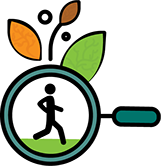
In order to gauge our users pain points a series of surveys and interviews were conducted. These targeted patents (users) and physiotherapists (stakeholders) who were dealing with musculoskeletal disorders. Questions to users focused on their attitudes, pain points and experiences within their current process during rehabilitation and questions to physiotherapists related to what is currently being implemented during rehabilitation, their attitudes towards this process and some of the key exercises that are required for successful rehabilitation. During this phase question were kept broad to allow research on a range of musculoskeletal disorders to be collected so that future integration could be incorporated.

Personas




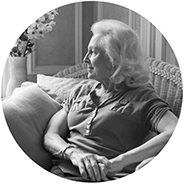



User Needs
- Regularly perform rehabilitation exercises.
- To be Educated to make more informed decisions.
- Reminders to do exercises outside of physical therapy.
- Guides to completing prescribed exercises.
- Ability to track and record recovery performance during exercises sessions.
- Ways to report how exercises are going to patient’s physical therapists for more accurate ongoing support.
- Motivation to complete prescribed exercises.
System Constraints
- The system needs to be small, light, discrete, not ‘appear medical’ or challenge the identity of the user. (Red Flag)
- The wearable technology needs to be able to be seamlessly integrated into users daily lives.
- Systems needs to be cost effective and be widely availability for patient use.
- The interface needs to be simple and easy to use.
- System need to be uplifting and motivating the user in an overall positive way.
Final Design Statement
To create a wearable technology solution for lower body musculoskeletal disorders (MSD) to better educate, assist and enhance the patient experience during their physical rehabilitation therapy.
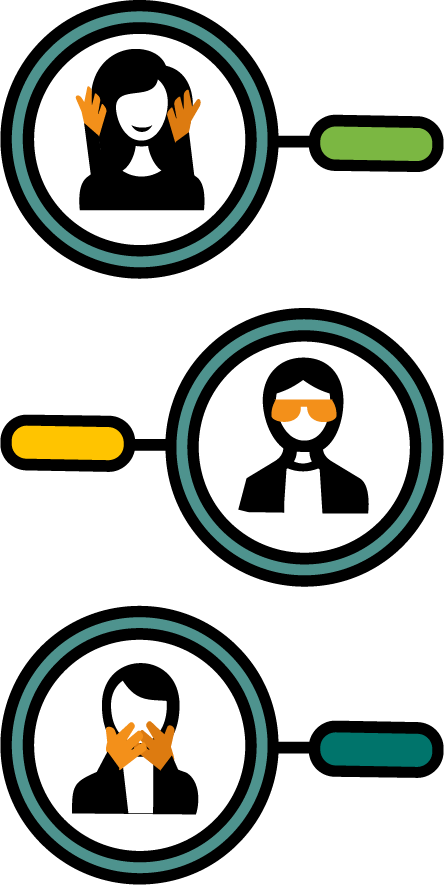
Initial Concepts
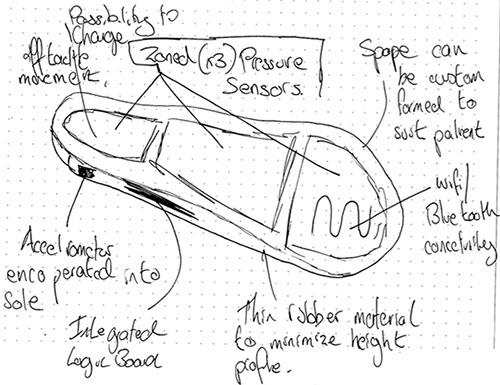
1. Smart Sole
The Interactive Sole is a shoe insert which is able to be placed within any shoe. This contains a series of 3 pressure sensors which allows for tracking of weight being placed on the foot and leg. An accelerometer is used for motion tracking of the foot and leg. It if formed from rubber which allows for free motion within the shoe minimizing the impact on the user. The in shoe design also results in no external awareness of the user wearing the product.
Response to User Needs
- Provides accurate daily monitoring of patient activities, is able to track and report to patient and physiotherapist.
- The Sole is able to be quickly added to any of the patients shoes allowing for easy integration into their daily lives, this also makes it an in-conspicuous to others.

2. Knee Wrap
The Knee Wrap is a product which can be place around the users knee similar to a compression bandage. It utilizes a bend senor located above the knee to measure how much the user is moving their knee. It also contains two electromyography sensors which are able to detect how much energy a muscle is creating - which give the system an indication of the load the user is able to apply to the leg. It also contains a small processor which is Wi-Fi and/or blue-tooth enabled allowing for a connection to the mobile application.
Response to User Needs
- Sensors connect with mobile device which allows for information to be tracked and reported back to the patient and physiotherapists.
- Device is able to be worn underneath clothing allowing for in-conspicuous use during the day.
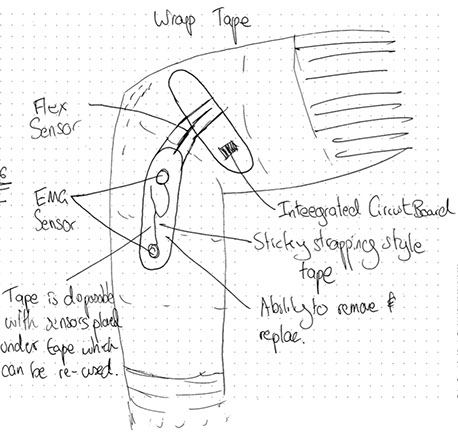
3. Smart Tape
Smart Tape is a semi disposable system which can be applied and removed as required by the user. It contains a series of modular electronic components which alight with a tape sticker which can be applied on the side of the users knee. It contains a EMG and flex sensor. These are able to detect knee bend and muscle activity. By using a disposable tape the user is able to remove the system and throw away the tape and then replace the electronic modules with another sticker the next time they need to use the system.
Response to User Needs
- The use of tape allows for cheap and accessible use of the technology.
- It is also slim and in-conspicuous once applied under clothing, otherwise maintains it’s appearance similar to sports strapping tape, making it appear reasonably normal for patients.
Technical Experiments
1. EMG Sensors
An electromyography sensor measures the electrical activity of a muscle. It is important that the sensor is located on the right part of the muscle to get the best reading possible. Best placement is on the midline of the muscle belly between an innervation zone and a myotendon junction. It is also best to clean the skin thoroughly before applying the electrode. The electrodes also have to be stuck onto the skin with a sticky adhesive, which poses a problem for integration into a wearable such as a sock. It takes away part of the ease of using a piece of clothing like a sock, which is easily removable.
2. Accelerometers
Accelerometers measure acceleration. They are often useful for sensing vibrations and orientation. Accelerometers can measure two types of acceleration, static and dynamic. Static acceleration is used to determine the orientation, and dynamic acceleration is used to measure how fast the device is moving. Accelerometers could be used to measure the angle of a knee joint by having an accelerometer attached to the leg and measuring the static acceleration.
3. Flex Sensors
Flex sensors can be used to measure bending, by the resistance increasing as it bends. A flat flex sensor has a resistance of 30kΩ and when bent to 90º the resistance will increase to as much as 70kΩ. Flex sensors are limited in that they can only flex in one direction. Flex sensors could be useful for measuring the angle of a joint.
4. Pressure Sensor
Also called Force Sensitive Resistors. The amount of pressure that is applied to the FSR varies the resistance of the sensor. The harder the force, the lower the resistance. The weight range of an FSR varies from sensor to sensor, but most commercially available sensors will have a weight range of 0.1kg-10kg. These sensors aren’t reliably accurate, and are best used to detect pressure rather than measure it. An array of FSR’s attached to a sole in a shoe could be useful for determining which areas of the sole are receiving the most pressure.


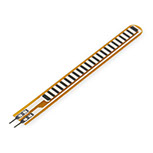
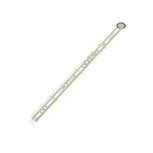
ReforMe Final Design Concept
Reforme is a wearable solution to assist in the rehabilitation of knee related musculoskeletal disorder. Incorporated into a sock patients are able to wear, Reforme is able to track, analyse, report and support MSD patients. Using a range of EMG, accelerometer and pressure sensors the sock will be able to track daily rehabilitation exercise targets. With the companion mobile application patients will be able to see exercise schedules, recommended activities as well as their current and historical progress during MSD rehabilitation. Data used in the App will also at rehab progress milestones be used to create generative artwork which can assist the patient in understanding how important the progress is while also rewarding their hard work.
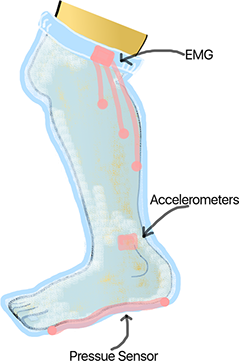
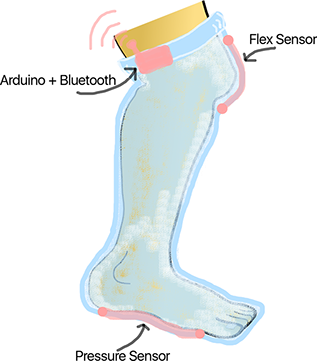
ReforMe Mobile Interface Design
For the interface design we went through three main stages of design. For the initial stage we all individually drew up versions of the application which we all traded amongst ourselves to complete a quick usability text/ Sanity check. This allowed us to come up with out own unique ideas for the direction of this application. Next in Keynote we consolidated our designs and testing to come up with pixel perfect grey scale versions of the application and functionality. After these where once again tested with users and we had a bit of a click through version to play with to make sure nothing was missing, we moved onto high fidelity visual design and a walk through. This was completed in Illustrator and Photoshop for the flat design with was then turned into two different walk throughs (Marvel for the app click through) and then a coded version in Processing that would link into the hardware prototype with them working in sync.
Initial Design
High Fidelity Mock-up




Usability Testing
The first type of testing completed during and throughout the development of ReforMe was usability testing with the focus on making our designs, products and services as accepting into the user’s lifestyles (these users being patients, physiotherapists and the support team). This was to maximize the chance of early adoption receiving the right support from our desired target market. This was demonstrated when we organised a meeting a with a sport rehabilitation and MSD specialist from the University of Sydney (Due to commercial associations they asked not be named when publishing ReforMe results). During this interview we had a lot of positive feedback with the high endorsements going to the application design and the extensive range of sensors we incorporated into the wearable producing highly accurate tracking
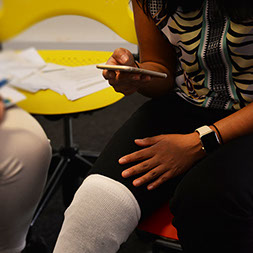
Project Evaluation
Functional Testing
Secondly we completed Functional testing, this was to see how the physical components were interacting with the system. As the prototype was built to be representative of a scalable system it was important to ensure what the data being produced was accurate and relevant to what ReforMe’s users needed. During testing, the flex sensor provided an accurate response to movement within the knee which showed in our tests while the EMG sensor had minor data issues but maintained consistent results once the sensor was fitted properly to participants. The data produced was effective in measuring muscle tension allowing us to know if the user needed to push themselves further or inform them they were working too hard enabling the prompting of rehabilitation technique improvements. During one stage it was identified that the store bought pressure sensor limited the ability to detect where weight was being placed on the bottom of the foot. This was resolved through the creation of a custom pressure sensor that not only reduced our fabrication costs but increased the accuracy our data. Combining all of these sensors within a sock proved to us and the user to be a reliable, resistant and unobtrusive method.





2 - 5
<
>
Accessibility Testing
Lastly we completed accessibility testing in two forms; the first being an online test to see how accessible our app is the visually impaired and blind community (http://webaim.org/resources/contrastchecker/). The Australian standard is to be able to pass a double ‘A’ standard. For this it requires a contrast ratio of 4.5:1 for normal text and a 3:1 for large text. Level AAA requires a contrast ratio of 7:1 for normal text and 4.5:1 for large text. Large text is defined as 14 point (typically 18.66px) and bold or larger, or 18 point (typically 24px) or larger. By adhering to this standard we are enabling our users to once again obtain full accessibility to the physical world as well as the digital world though our application and the support they would get to a full recovery.
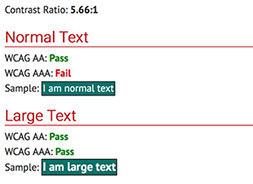
Usability Testing Video
Click Through Prototype
Project Evaluation
Due to the positive usability testing and results obtained, we were able to quickly and efficiently dive into our development process. Completing the three types of testing between ourselves and our users thought development; worked well in our favor as we were able to continually reiterate our designs over different fidelities so that when it came to the final high fidelity prototypes we had a product that was positively enhancing the pain points we initially identified. We feel we were able to challenge our foundational skills too new levels though this project with the use of industry software and materials such as; Marvel, Photoshop, Illustrator, Arduino, Industry coding languages. The use of this software/hardware enabled us to take the project to an industry standard not seen by many university projects. It also enabled us to develop a holistic experience and system that could be pitched to a kick-starter community for further development. As well as this we can see possible collaboration opportunities arising with areas such as physiotherapist, Astronauts, Athletes and any knee related injuries. We are all excited to see where this project could develop in the future, as we have completed a submission into the 23rd AIMIA Awards and there is also increasing industry interest and investment for major developments and ideas into this area.
The Team

Christopher Simpson
Development Lead
Zachary Bacon
Research/Project Team
Isabella Bain
Design Lead
Contact Us
© 2017 CHRISTOPHER SIMPSON AND ISABELLA BAIN ALL RIGHTS RESERVED
